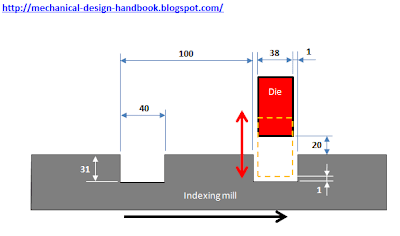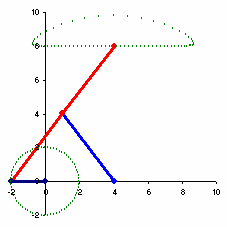Timing Diagram (Part 3 - Cycloid Cam Profile Analysis)
In previous post [Timing Diagram (Part 2 - Maximum acceleration calculation)], we calculated the maximum acceleration of the die using cycloid cam profile. We found out that this maximum acceleration of the die can be reduced if we can extend the indexing angle (Bm) or indexing time (tm) through overlap motion.
Then, let's see how we can calculate for the suitable indexing angle to reduce the acceleration of the die.
Cycloidal motion cam profile has movement equation as follows.
h = hm x [t/tm - 1/(2 x pi) x sin(2 x pi x t/tm)]
Rearrange the equation to get
h/hm = t/tm - 1/(2 x pi) x sin(2 x pi x t/tm)
The displacement profile can be plotted as shown below (dimensionless).
We can see that at the first 10% of indexing time, the movement is just only 0.65% of the total movement (stroke) and at 90% of time, the remaining movement for the die is only 0.65% of the total movement (stroke). Or we can say that, there is not much movement at the first and last 10% of indexing time.
For this example, the indexing mill has an indexing angle of 150 deg and stroke of 100 mm.
That means at 10% of indexing angle (time) = 10% x 150 = 15 deg, the indexing mill moves only 0.65% x 100 = 0.65 mm. (Let's say we use the margin of 0.65 mm)
The effective angle (time) of the indexing mill = 150 - 2x15 = 120 deg.
The remain cam angle = 360 - 120 = 240 deg.
Since the die has to stay at the bottom for 100 deg to do the job, the remaining cam angle becomes 240 - 100 = 140 deg.
If we divide the movement of the die equally, the angle for moving up and down becomes 140/2 = 70 deg. This is when the die starts moving down from 205o - 70o = 135 deg to 205 deg with the movement of 50 mm. But this is not good enough. We can do more overlap!!
If we reconsider the timing diagram again, at first the die waits for the indexing mill to complete its movement. But we can see that the die does NOT have to wait for the indexing mill to complete the movement. If we take the margin of 1 mm between the die and the indexing mill, the die can move already = 20 - 1 = 19 mm when the indexing mill has the remaining movement of 0.65 mm (at 135 deg).
When the die moves 19 mm, the percentage of movement can be calculated as follows,
h/hm = 19/50 = 38%
From the following table, we found that t/tm = 44% (approx).
This means the die can move already 44% of indexing angle (time). It has the remaining angle to move = 100% - 44% = 56%.
The remaining angle of 56% is equal to 70 deg.
Thus, the new indexing angle = 70 deg./56% = 125 deg
Actually we should take margin of 5 deg for adjustment on the cam (installation error). That means the indexing angle = 125 - 5 = 120 deg. But for this example, I would use the indexing angle of 125 deg for explanation :)
The new timing diagram with overlap is as follows.
hm = 50 mm = 0.05 m
tm = 10Bm/N = 10(125)/2000 = 0.625 s
amax = 2 x pi x hm/tm2 = 2 x 3.141592654 x 0.05 / 0.6252
In the previous timing diagram (without overlap) the maximum acceleration = 4.154 m/s2
So the maximum acceleration reduces = 4.154/0.804 = 5.17 times !!
In the next post [Timing Diagram (Part 4 - Timing Diagrams Comparison using Motion Simulation in Microsoft Excel)], we will see the simulation of motion between both timing diagrams in Microsoft Excel. You can see by yourself the different in each movement.
Then, let's see how we can calculate for the suitable indexing angle to reduce the acceleration of the die.
Cycloidal motion cam profile has movement equation as follows.
h = hm x [t/tm - 1/(2 x pi) x sin(2 x pi x t/tm)]
Rearrange the equation to get
h/hm = t/tm - 1/(2 x pi) x sin(2 x pi x t/tm)
The displacement profile can be plotted as shown below (dimensionless).
We can see that at the first 10% of indexing time, the movement is just only 0.65% of the total movement (stroke) and at 90% of time, the remaining movement for the die is only 0.65% of the total movement (stroke). Or we can say that, there is not much movement at the first and last 10% of indexing time.
For this example, the indexing mill has an indexing angle of 150 deg and stroke of 100 mm.
That means at 10% of indexing angle (time) = 10% x 150 = 15 deg, the indexing mill moves only 0.65% x 100 = 0.65 mm. (Let's say we use the margin of 0.65 mm)
The effective angle (time) of the indexing mill = 150 - 2x15 = 120 deg.
The remain cam angle = 360 - 120 = 240 deg.
Since the die has to stay at the bottom for 100 deg to do the job, the remaining cam angle becomes 240 - 100 = 140 deg.
If we divide the movement of the die equally, the angle for moving up and down becomes 140/2 = 70 deg. This is when the die starts moving down from 205o - 70o = 135 deg to 205 deg with the movement of 50 mm. But this is not good enough. We can do more overlap!!
If we reconsider the timing diagram again, at first the die waits for the indexing mill to complete its movement. But we can see that the die does NOT have to wait for the indexing mill to complete the movement. If we take the margin of 1 mm between the die and the indexing mill, the die can move already = 20 - 1 = 19 mm when the indexing mill has the remaining movement of 0.65 mm (at 135 deg).
When the die moves 19 mm, the percentage of movement can be calculated as follows,
h/hm = 19/50 = 38%
From the following table, we found that t/tm = 44% (approx).
This means the die can move already 44% of indexing angle (time). It has the remaining angle to move = 100% - 44% = 56%.
The remaining angle of 56% is equal to 70 deg.
Thus, the new indexing angle = 70 deg./56% = 125 deg
Actually we should take margin of 5 deg for adjustment on the cam (installation error). That means the indexing angle = 125 - 5 = 120 deg. But for this example, I would use the indexing angle of 125 deg for explanation :)
The new timing diagram with overlap is as follows.
The maximum acceleration of the die can be calculated as follows,
N = 2000 pcs/h
Bm = 125 deghm = 50 mm = 0.05 m
tm = 10Bm/N = 10(125)/2000 = 0.625 s
amax = 2 x pi x hm/tm2 = 2 x 3.141592654 x 0.05 / 0.6252
amax = 0.804 m/s2
In the previous timing diagram (without overlap) the maximum acceleration = 4.154 m/s2
So the maximum acceleration reduces = 4.154/0.804 = 5.17 times !!
In the next post [Timing Diagram (Part 4 - Timing Diagrams Comparison using Motion Simulation in Microsoft Excel)], we will see the simulation of motion between both timing diagrams in Microsoft Excel. You can see by yourself the different in each movement.








Comments